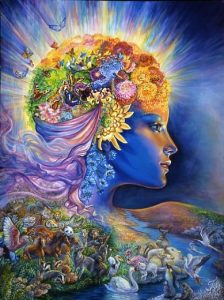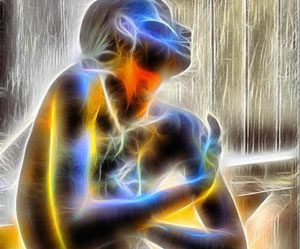 We had the final meeting of our Introduction to Meditation and Mindfulness series at Yoga Bliss today. The course content is adapted from the wonderful work of Insight Meditation teacher, Gil Fronsdal.
We had the final meeting of our Introduction to Meditation and Mindfulness series at Yoga Bliss today. The course content is adapted from the wonderful work of Insight Meditation teacher, Gil Fronsdal.
Last week we focused on mindfulness of emotion. We use the breath to stabilize our attention and then we focused the lens of attention on the compelling emotions, feeling freely in sustained awareness. This week we bring in mindfulness of thought.
Welcome Everything
We try to develop mindfulness to be all inclusive, to include all aspects of our life. To include breath, body, emotions, thoughts, the world we encounter – sights, sounds, smells, everything. Nothing is outside of awareness. That is what makes it sacred. The term “Big Mind” is sometimes used to describe the mind that holds everything. That doesn’t mean that we don’t act with discernment in the world. We keep our awareness and our hearts open, even though we might say no to something.
 We keep our hearts and minds open through the strengthening of mindfulness. As mindfulness gets stronger and stronger, our attention is set free from what we are mindful of. When we have strong sensation or pain in the body – we often react to it, we tense around it or try to push it away. We may have feelings of anger, despair or self-pity. All these strong reactions can become entangled with what we are attending to. As mindfulness gets stronger, mindfulness itself begins to disentangle itself; it becomes independent. An analogy often used is that of a lotus flower. A lotus flower grows up out of the muddy water, but as it blooms it’s untouched by the mud. A beautiful white lotus is rooted in the mud, but it’s not touched by the mud. It has this purity. As the mindfulness gets stronger it’s becoming free from the mud, the places of attachment or aversion. In mindfulness meditation, we aim to be aware of thoughts. To include them in awareness, and in that inclusion, with time, learn to be free of them. Sometimes the mind does become silent.
We keep our hearts and minds open through the strengthening of mindfulness. As mindfulness gets stronger and stronger, our attention is set free from what we are mindful of. When we have strong sensation or pain in the body – we often react to it, we tense around it or try to push it away. We may have feelings of anger, despair or self-pity. All these strong reactions can become entangled with what we are attending to. As mindfulness gets stronger, mindfulness itself begins to disentangle itself; it becomes independent. An analogy often used is that of a lotus flower. A lotus flower grows up out of the muddy water, but as it blooms it’s untouched by the mud. A beautiful white lotus is rooted in the mud, but it’s not touched by the mud. It has this purity. As the mindfulness gets stronger it’s becoming free from the mud, the places of attachment or aversion. In mindfulness meditation, we aim to be aware of thoughts. To include them in awareness, and in that inclusion, with time, learn to be free of them. Sometimes the mind does become silent.
Boats of Thought
 We visualized our thoughts as boats floating down the river. We’ve established ourselves sitting peacefully on the riverbank breathing, content and happy. Perhaps a thought boat floats by and we didn’t see it coming. We might gradually become aware after a few minutes that we’ve been caught up in that particular thought world. A common one is planning, the word tomorrow bubbles up in our mind, and then we begin planning tomorrow, all the things we’re going to do and say. Or another thought comes up about the past, and we start living in the world of regrets, or beautiful thoughts of how wonderful it was in the past. . . . So much of life is lived on these boats of thinking. Some of them are beautiful. Others are quite painful and cause a lot of suffering to ourselves and to others. But even when they are healthy thoughts, they also carry us down the river. We lose our spot on the riverbank where we are on solid ground, centered, and where we can be independent and free. One of the things we’re trying to do in meditation practice, is to find ourselves on the riverbank and learn to let our thoughts go by.
We visualized our thoughts as boats floating down the river. We’ve established ourselves sitting peacefully on the riverbank breathing, content and happy. Perhaps a thought boat floats by and we didn’t see it coming. We might gradually become aware after a few minutes that we’ve been caught up in that particular thought world. A common one is planning, the word tomorrow bubbles up in our mind, and then we begin planning tomorrow, all the things we’re going to do and say. Or another thought comes up about the past, and we start living in the world of regrets, or beautiful thoughts of how wonderful it was in the past. . . . So much of life is lived on these boats of thinking. Some of them are beautiful. Others are quite painful and cause a lot of suffering to ourselves and to others. But even when they are healthy thoughts, they also carry us down the river. We lose our spot on the riverbank where we are on solid ground, centered, and where we can be independent and free. One of the things we’re trying to do in meditation practice, is to find ourselves on the riverbank and learn to let our thoughts go by.
We can’t stop the boats going by. We can’t stop our thoughts, but we don’t have to necessarily be carried away by them.
We explored the process of becoming mindful of thinking in the Guided Meditation on Mindfulness of Thought.
The Elusive Mind
 The process of thinking can be elusive, especially when we attempt to focus our attention on it. In mindfulness, we become aware of how our thinking often triggers and then perpetuates anxiety and stress in our lives. Sometime it’s not easy to let go of thinking and return to the breath. The mind might be charging ahead or you might let go of thinking for a moment and then it seems to rebound back. If either one of those two things happen, then you let go of paying attention to your breathing and then focus on this phenomenon of thinking. Like looking at it right in the eye. “Thinking, I see you.”
The process of thinking can be elusive, especially when we attempt to focus our attention on it. In mindfulness, we become aware of how our thinking often triggers and then perpetuates anxiety and stress in our lives. Sometime it’s not easy to let go of thinking and return to the breath. The mind might be charging ahead or you might let go of thinking for a moment and then it seems to rebound back. If either one of those two things happen, then you let go of paying attention to your breathing and then focus on this phenomenon of thinking. Like looking at it right in the eye. “Thinking, I see you.”
As soon as you become aware and name thinking, you disentangle your self from the pull of mindless thought. This is the beginning of breaking old habits. Most of us have spent a lifetime in thought, wandering from distraction to distraction. Consciously choosing to stay present is a very meaningful step toward breaking unconscious habit.
Beyond Content to the Here and Now
The complex process of thinking involves much of who we are. Beyond content, thought involves our body. Almost every thought will have a physical sensation. There is often an emotional component to thinking as well. There might be an energetic aspect. Inner voices, visual words, images, visualizations are all forms of thought. People process things differently. We investigate body sensations, emotions and energy that surface.
 We can carefully attend to the process of thinking. We attempt to let go of the content of our thoughts. We notice the physical dimensions of thought – a sense of pressure or tightness in the head, tension in the forehead or around the eyes. Constricted breathing. We feel the areas of tension and see if we can relax them or the edges around them. This process may release some of the pressure to think.
We can carefully attend to the process of thinking. We attempt to let go of the content of our thoughts. We notice the physical dimensions of thought – a sense of pressure or tightness in the head, tension in the forehead or around the eyes. Constricted breathing. We feel the areas of tension and see if we can relax them or the edges around them. This process may release some of the pressure to think.
When we find something in the body, we can let go of thinking. We become mindful of the bodily sensations around thinking and relax if possible. If we struggle with relaxation we try to be content with being aware, bringing our presence to the present. In presence, we’re doing the practice. Nothing has to change. We don’t have to fix anything. Mindfulness is not thoughtfulness.
Thoughts can also have an emotional component. Thoughts about planning are often correlated to anxiety, apprehension or fear. Of course planning may be related to anticipation, creativity and delight. These states fuel the flow of thought. We can be mindful of these emotions. Feel fear or feel anticipation. Name the emotion, allow it to be there, feel it in the body and watch how it changes.
The body, the physical sensations connected to thinking, and the emotions happen in real time, in the here and now. It’s interesting to watch how the sense of energy or vitality or aliveness in the body shifts and changes depending on what we’re thinking about. If we are connected to the body, to the emotions, we are here now. If we are caught up in the world of thoughts, in a sense, we might be somewhere else. We’re trying to be here. The emotional aspect of thinking, the physical aspect of thinking, help anchor us in the present moment.
 Mindfulness is not thinking about something. Thinking about a massage and experiencing a massage are very different. You can get a wonderful massage, and if you are thinking about what the experience is, it’s very different than sinking into the muscles allowing yourself to really feel the fingers of the masseuse. It’s tactile, it’s very present. You don’t need to think to feel the tactile experience of the massage. Thinking about music and deeply listening to music are very different. You can have a silent mind.
Mindfulness is not thinking about something. Thinking about a massage and experiencing a massage are very different. You can get a wonderful massage, and if you are thinking about what the experience is, it’s very different than sinking into the muscles allowing yourself to really feel the fingers of the masseuse. It’s tactile, it’s very present. You don’t need to think to feel the tactile experience of the massage. Thinking about music and deeply listening to music are very different. You can have a silent mind.
If we can’t turn off thinking, our job is to study it. Become very familiar with what it feels like to have thinking on all the time. What does it feel like physically? What does it feel like energetically? One of the things to notice about incessant thinking is the weary mind. Our thinking minds can be exhausted. They don’t get a break. So we can notice that. What does it feel like? What’s the subjective sense of a tired mind?
Closing Remarks and Homework
If this approach feels overwhelming, it’s really enough to just stay with the breath. You don’t have to do this exploration of thoughts, if it seems too complicated. It’s something to have in the back of your mind, and you might find it useful in it’s own time and place. Keep these instructions in the back of your mind and use them when it is helpful.
 Just keep faith with mindfulness practice. Steady and relaxed, keep coming back to the breath. Use your breath, and when it’s really compelling, your physical sensations, where they are arising around emotions, arising around the world of thinking, you can begin exploring in this mindful way.
Just keep faith with mindfulness practice. Steady and relaxed, keep coming back to the breath. Use your breath, and when it’s really compelling, your physical sensations, where they are arising around emotions, arising around the world of thinking, you can begin exploring in this mindful way.
In mindfulness practice you begin appreciating and valuing noticing what’s going on. You are like a naturalist. Your field studies are yourself. You can find some practice suggestions to help you along the way: Introduction to Meditation Mindfulness of Thought.
